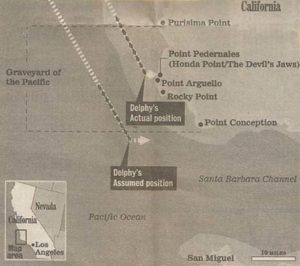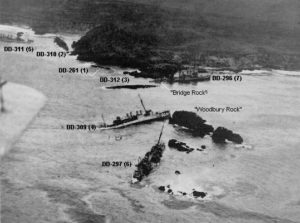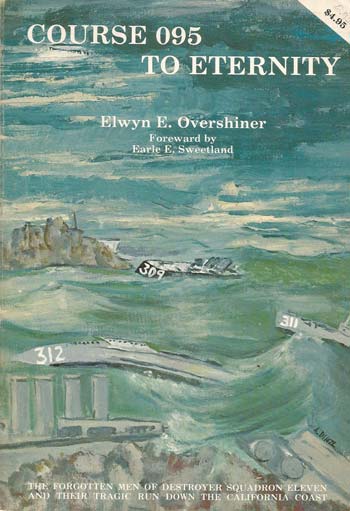‘Devil’s Jaw’ Crunches Seven Navy Destroyers

Map shows location of wrecks at Pt. Pedernales or “Honda Pt.”, Credit: Baltimore Sun
Cruising from San Francisco, to their home port in San Diego, nine in a fleet of 14 destroyers followed the lead vessel and crashed on the rocks of Point Pedernales, Southern California. As two of the ships backed off and limped away, 23 sailors died in this dark episode of naval history. Many of the 800 survivors were commended for their rescue efforts during the ensuing debacle as they helped victims in distress. Local fishermen took crews off the USS Fuller and USS Woodbury, while ranchers set up breeches buoys from the top of nearby cliffs. Good Samaritans from Lompoc, a coastal town 15 miles north, brought food, clothing and blankets to the scene.

Devil’s Jaw wrecks from “wrong turn” on September 23, 1923, Credit: U.S. Navy
Like tenpins colliding on a bowling alley, the USS Delphy, USS S.P. Lee, USS Young, USS Woodbury, USS Nicholas, USS Fuller and USS Chauncey struck the shoals or each other and sank within five minutes. The damaged USS Farragut and USS Sommers backed off into deeper waters. The USS Young took the worst hit and rolled over. Although there were many dramatic rescues by shipmates, 20 of this vessel’s seamen died. Among the heroics, Chief Boatswain’s Mate Arthur Peterson leaped into the swirling sea and swam 100 yards to the USS Chauncey where he attached a heavy line to a lifeboat. More than 30 men were saved in rescue trips made between the ships. Peterson and scores of others were later cited for leadership and bravery. Seven “Greyhounds of the Sea”—a pet name for their sleek design and speed—or “tin cans” named for their thin steel hulls, were now on the Navy’s “Ships Lost at Sea” list.
A Navy Court of Inquiry registered the disaster as “a bad error of judgment and faulty navigation” aboard the USS Delphy. It asserted that the other ships’ masters had put “too much blind faith in the squadron commander and took little initiative in determining their own positions.” A General Court Martial, held at naval headquarters in San Diego, found Commander Donald T. Hunter and Capt. Edward H. Watson guilty of “culpable inefficiency and negligence.” Both were released from arrest and returned to duty with stipulations that no future promotions were possible during the remainder of their careers. Ten other officers charged in the court martial were exonerated.
In the aftermath, the American public remained dubious, questioning whether or not all information on the Honda miscue had been revealed. The Navy was suspected of a cover-up, but subsequent civic probes did little to dispel the doubt. Ironically, official records of the findings and opinion of the Court of Inquiry disappeared from the Judge Advocate General’s office not long after the proceedings ended.

Elwyn Overshiner’s book about the Squadron Eleven disaster, Credit: Camille Overshiner
Diving on the remains of Squadron Eleven is a touchy subject. After the Navy went through the wreckage recovering armaments and munitions, salvage rights were sold to Merritt, Chapman and Scott. But the company didn’t realize the gargantuan task it faced while hemmed in by the steep cliffs on one side and the rocky terrain seaside. Thus many “goodies” were left for California’s wreck diving brass hounds that got their share before the Honda Point site was declared off limits to civilians. Vandenberg Air Force Base and the Naval Missile Facility at Point Arguello own the 35-mile-long, 100,000 acres of land along the coast. The sea remains a Marine Protected Area (MPA) where diving, fishing and other activities are banned.
The Honda hulks are by no means an ideal dive site. Visibility is 0 to 35 feet depending on winds and currents. Conditions deteriorate quickly when the surf’s up. The vessels, embedded in the sand in waters 8 to 40 feet deep, barely break the surface on ebb tides having taken a pounding by fierce weather patterns over the years.
A memorial plaque on a bluff overlooking the ‘Devil’s Jaw’ commemorates the loss of seven ill-fated ships and 23 men. Artifacts recovered from the site—testimonials to history and heroics—are on display at Lompoc Museum. One of the many tributes reads: “Natural forces and human error created a perilous journey that brought to light the strength, courage and intrepid spirit of the brave tin can sailors.”
Author: Ellsworth Boyd
Ellsworth Boyd, Professor Emeritus, College of Education, Towson University, Towson, Maryland, pursues an avocation of diving and writing. He has published articles and photo’s in every major dive magazine in the US., Canada, and half a dozen foreign countries. An authority on shipwrecks, Ellsworth has received thousands of letters and e-mails from divers throughout the world who responded to his Wreck Facts column in Sport Diver Magazine. When he’s not writing, or diving, Ellsworth appears as a featured speaker at maritime symposiums in Los Angeles, Houston, Chicago, Ft. Lauderdale, New York and Philadelphia. “Romance & Mystery: Sunken Treasures of the Lost Galleons,” is one of his most popular talks. A pioneer in the sport, Ellsworth was inducted into the International Legends of Diving in 2013.
5 Comments
Submit a Comment
All Rights Reserved © | National Underwater and Marine Agency
All Rights Reserved © | National Underwater and Marine Agency
Web Design by Floyd Dog Design
Web Design by Floyd Dog Design

I enjoyed your article about the ‘Devil’s Jaw.’ Some years ago, was there a controversy in court where recreational divers sued the Navy in order to dive the Honda wrecks?
Thank you. It was an interesting shipwreck to research. Yes, I heard that years ago one of the members of the California Wreck Divers Club brought a suit against the Navy, actually the government, asking that a ban on recreational diving be lifted from the Honda Point site. To the best of my knowledge, nothing ever came of it. If any people have further information, I would appreciate their comments.
Hello Mr Boyd, I have been looking for a “good” place for some documents, books and pictures that I acquired 20 years or so ago in Brookings, Oregon. It was an estate sale by the relatives of one deceased, Joe Silva. It contains 2 or 3 books/manuscripts … I think Joe was writing , and had written, books on the subject. – Honda Left Turn 095 – “9 Turn” narrative of the Destroyer disaster at Honda Head” These previous two are unbound copies-
The hardback book Tragedy at Honda, by Lockwood and Adamson. – A softcover book by Joe Silva – called” Jalama Beach Park”. Then pictures. 17 or so small photos. Some with info on reverse.. Just Negatives of a picture of the wreck with many signatures of( i assume ) survivors of the tragedy. I can ship it all media mail – Let me know – my email is odish@charter.net –
My Great Uncle wrote this book
Thanks for sharing. I used this book while researching my article. It is well written and very informative. Your great uncle did a fine job.